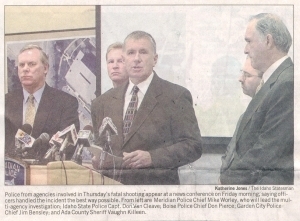Civilian Review of Police Actions – Part II
In this post, I’ll look at what I listed as the fourth type of civilian review authority:
Civilian review staff may receive complaints directly from the public and have the authority to independently investigator those complaints. The civilian review authority independently makes recommendations for findings to the chief or sheriff.
For purposes of this discussion, I’ll look at the Office of the Community Ombudsman, the civilian review authority in Boise, Idaho.
History
From January 1996 to September 1997, the Boise Police Department’s officers were involved in seven officer-involved shootings. In all cases except the first, the suspect or suspects were killed. Additionally, in the September 1997 case, Officer Mark Stall was killed. He was the first Boise Police officer to die in the line of duty in the department’s 103 year history.
Because of the frequency of the incidents, many citizens became alarmed at the perceived increase in violence in their city. At this time, the criminal aspects of each shooting were investigated by the Boise Police detective division, including one incident in November 1996 which involved a Boise homicide detective. Public concern of this practice was escalated when senior police officials made public statements in support of the officers’ actions, often within hours of the shooting incident when it was clear that no comprehensive investigation could have taken place. (During this time, I was in charge of the homicide unit, as well as other elements of the Criminal Investigation Division, and thus nominally in charge of the criminal investigations.)
The public began to call for an outside review of the shootings, specifically, and of complaints against the police department in general. At first, the notion was resisted by the mayor and other elected officials, as well as the police chief. However, in time, the city decided to implement a civilian review authority. After two abortive attempts to hire someone for the position, the city finally hired former Boise Cascade Corporation Human Resources executive Pierce Murphy.
By the time this occurred, I had been transferred to command Internal Affairs. It was my responsibility to directly investigate allegations of police misconduct. Additionally, I would personally investigate officer-involved shootings for any policy violations. This would put me in direct contact with Murphy and his office.
The Office of the Community Ombudsman
Initially, I found Murphy to be skeptical of any working relationship with Internal Affairs. However, as we worked to forge a delineation of responsibilities, we both came to respect each other’s work ethic and view of the process.
In setting out responsibilities, we developed guidelines which would serve both the citizens and the department.
Citizens were free to contact either Internal Affairs or the Ombudsman with concerns about police actions. However, we put in place a good communication system to alert each other about such contacts and agreed that once one agency had accepted a complaint, the complaining citizen could not then file the same complaint with the other agency. Consistent with the Ombudsman’s charter, however, a citizen whose complaint was investigated by Internal Affairs could appeal the finding to the Ombudsman.
Neither Internal Affairs nor the Ombudsman had a role in disciplinary action for officers found to have violated policy. That was the purview of the police chief.
The Ombudsman could randomly review Internal Affairs investigations for conformity with best practices.
Internal Affairs and the Ombudsman would jointly investigate any officer-involved shooting case from a policy standpoint.
Concurrently, the Boise Police Department entered into an agreement with four other agencies in the immediate area for an Officer-Involved Shooting Task Force to investigate criminal aspects of such cases. This would eliminate perceived bias when an agency was ‘investigating itself.’ All five agencies would contribute seasoned homicide detectives to the task force.  However, the agency employing any officer involved in a shooting incident could never take a lead role in investigating that incident. (This became an interesting point later after I had become the police chief in one of the member agencies. There was a shooting incident in which officers of four of the five agencies were directly involved in engaging the gun-wielding suspect. My agency, the Meridian Police Department, took the lead role since we were the only non-involved agency of the task force. Photo is from the initial news conference of this case where it was announced who would take the lead.)
However, the agency employing any officer involved in a shooting incident could never take a lead role in investigating that incident. (This became an interesting point later after I had become the police chief in one of the member agencies. There was a shooting incident in which officers of four of the five agencies were directly involved in engaging the gun-wielding suspect. My agency, the Meridian Police Department, took the lead role since we were the only non-involved agency of the task force. Photo is from the initial news conference of this case where it was announced who would take the lead.)
In the next installment, we’ll look at the reaction of both officers and the public as well as the long term working relationship between Internal Affairs and the Ombudsman.
The post Civilian Review of Police Actions – Part II appeared first on .
Mike Worley's Blog
- Mike Worley's profile
- 9 followers



